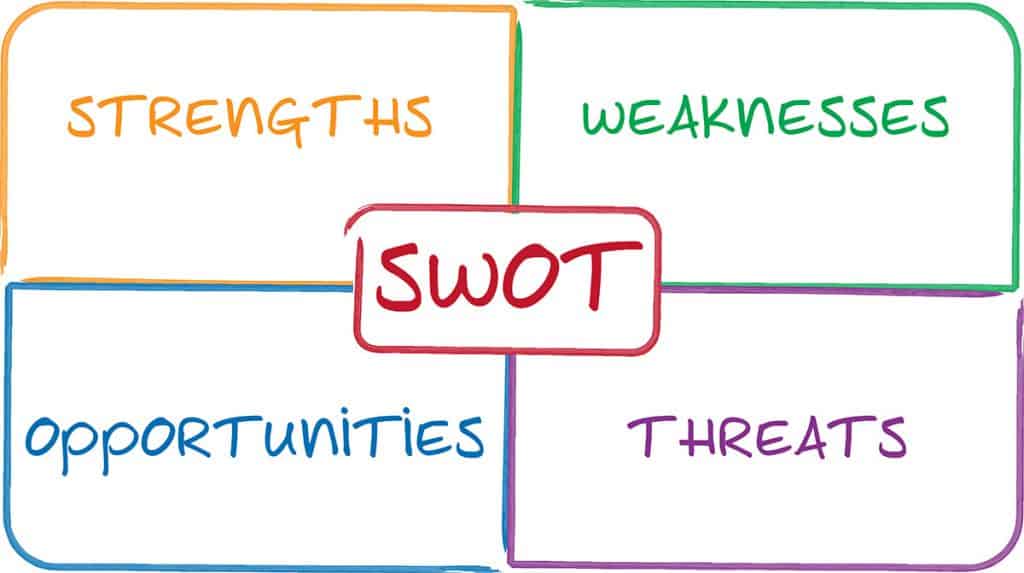SWOT analysis (an acronym of Strength, Weaknesses, Opportunities, and Threats) )has been in use since 1952! And it still works. Such a great tool to give us a snapshot about your business, your marketing.
It’s always part of the strategies planning and reviews, and I also love using it when I have to decide whether or not to go ahead with an idea (if there are more threats and weaknesses I don’t bother, except…but this is another episode.)
SWOT analysis is more complex than a simple table, but for the purposes of this episode, I’ll keep it simple, as always.
Listen to the episode by clicking on the below recording:

So today let’s talk about SWOT. This is really an old tool and it’s not by chance that it’s still in use. SWOT is really the actual name and the individual letters stand for
– strength – internal strength you have in the organization around you – the people.
– Weaknesses, again internal weaknesses in the organization. Lack of resources.
– Opportunities which are external. So what is the environment that could give you hope for nice opportunities?
– And threats – again external.
It’s quite simple to do, just sit down with the team or yourself and fill it in. To give you a few ideas on how to do it and then it’s an easy decision whether to go ahead with an idea or not. Because obviously when you have a lot of strengths and just a few weaknesses and there are a lot of opportunities, not so many threats, then it’s a good idea
And sometimes you just find out that there are so many weaknesses. It’s so complicated there are no resources. Then it’s not a good idea to go ahead. Just be honest.
Anyway, just seeing it in this grid helps you a lot and it also helps you to be honest. I’m just using it when I know I’m planning an event.
Just a few ideas for how you could fill it in yourself and for your business.
Internal strength could be: Your experience in your profession, that your product is validated already. So when you plan something and you build it on something which is already validated. You have skills in your team. You’re already very good at something that you can develop further with the new idea. When you already have good client testimony as press coverage. It could be a really good strength. And you already have some communication assets running and you don’t have to set it up. Then you have a team to help you when you have resources to help you. When your brand is already well known or there’s somebody in the team, somebody would join you or support you. These are all strengths: Resource, reputation profile, communication assets, skills.
Obviously, these are just some general things. I don’t know your service or product but you might have some specific strengths that I cannot cover here, right?
Weaknesses on the other hand are all the opposite to this. Just a few ideas: When there’s a misconception about that product or service. So people just generally say that: “Wow it’s boring, it’s something I don’t need.”
When it’s not a basic need.
When there is a limited budget for marketing or limited resources. When there are limits to the product: You cannot do it online. Or you can only do it online
So these are just some examples for you of how to think of weaknesses. You’re in love with your business and your product and your idea but you have to be honest. Like: Okay how can I take it offline? Or it’s not possible online. Or it’s online but we’re very much dependent on technology and our target group is elderly people and they won’t know how to do it.
Okay so let’s be honest with weaknesses really.
Then external opportunities like: There are new market niches that we’ve discovered and we could step into it and we have all the tools to do that. Or we could expand into other areas and other regions, even globally because now we switched to online or it’s something that doesn’t have to be translated or we can reach all the English-speaking countries.
On the other hand, threats could be the opposite. Again: When it’s too local we won’t be able to reach anybody. Obviously, uncertainty is a threat and sometimes we have to say that this is too much of a threat because what we plan is really very much about people meeting or conferences. It’s a big threat that for some months or years it won’t be possible. Then a threat is competitors. When I say that something that I’m doing is a great idea but very easy to copy then it’s a threat. Then others will copy it very easily and then I have to go back and say okay how do I change it.
Another threat could be a change in regulations or Brexit whatever is coming up. Obviously, there are no guarantees – never. That’s the beauty of it really.
But once you fill it in you will see where you have strengths, weaknesses, etc.
It’s not long hours of exercise. Just sit down and be honest with yourself.
So if you use this tool and the 3P diagram you will get much closer to deciding whether or not that idea is something to go ahead with.
